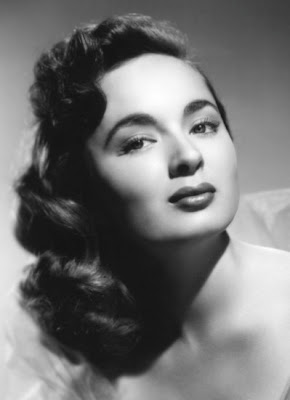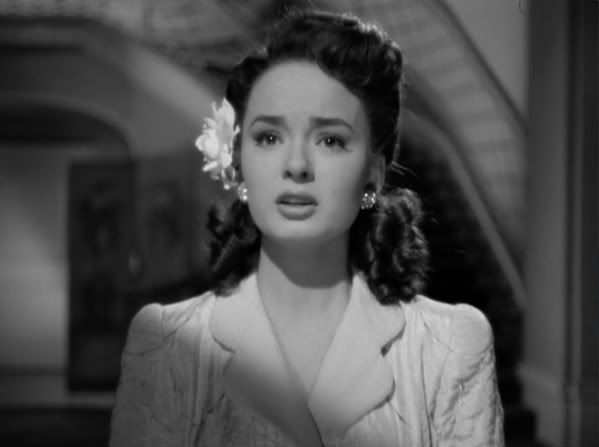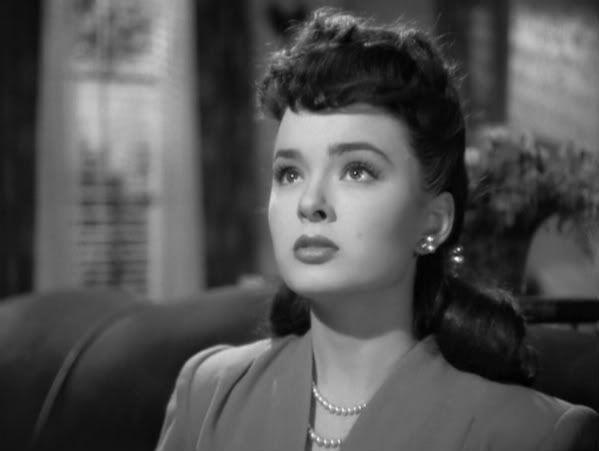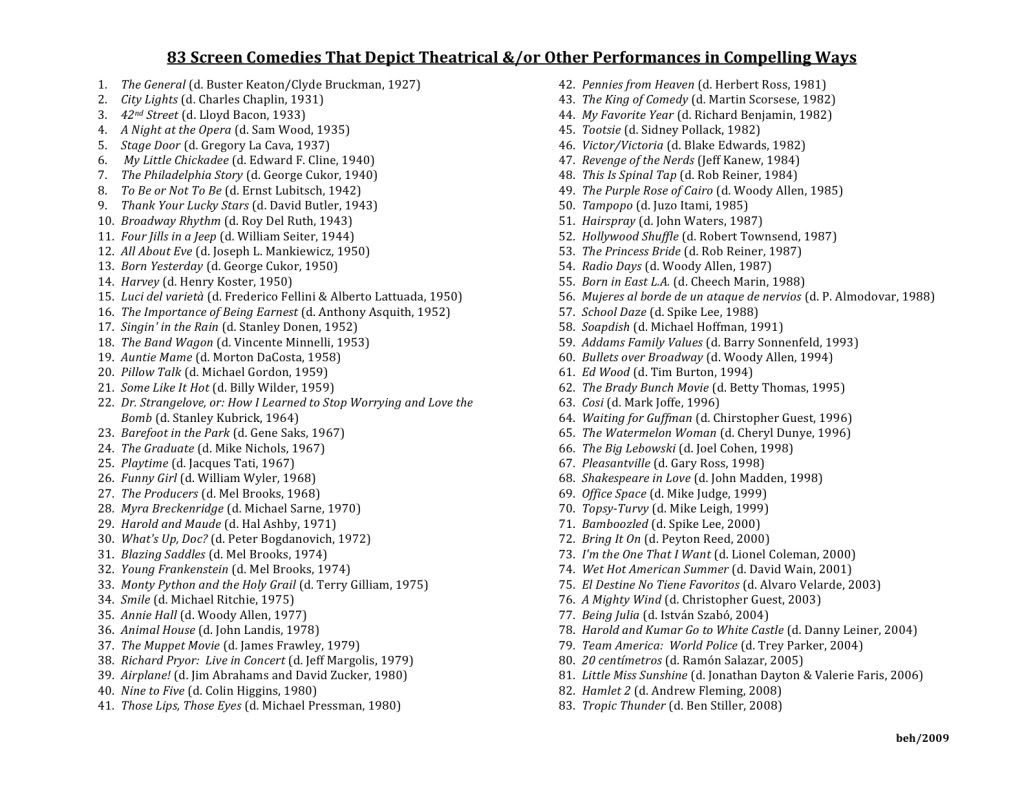 At long last...
At long last...My introduction to Ann Blyth came through what is possibly her 2nd-most legendary performance, as a 1970s-era spokesmodel for Hostess snack cakes. I remember, as a wee lil stinky, watching these commercials (in which the elegant Blyth serves Twinkies on the finest china) and just longing for my grandmother to fall under Ann Blyth's spell, to suddenly realize that "freshness never tasted so good" as when it came in plastic-wrapped single servings. But, alas, my grandmother never fell under Ann Blyth's sway in that way. I, however, did -- so much so that was appalled at my recurring, involuntary cravings for such Hostess goodness every time I, since December, screened (and rescreened) the most deservedly legendary performance by...


...Ann Blyth in Mildred Pierce (1945)
approximately 28 minutes and 50 seconds
30 scenes
roughly 26% of film's total running time
 When we first meet her, Blyth's Veda is shocked and confused by the police's interest in her mother and, even as the police cart her off, Crawford's Mildred assures her daughter that everything will be fine. In this scene, Blyth delivers a compelling "first hit" of the character as a guileless innocent, as a sweet girl naïve to the world and concerned only for her mother's welfare. This scene -- in which Blyth's Veda stands as a vision of daughterly sympathy and concern -- provides the essential foundation for the deft characterization that is to follow.
When we first meet her, Blyth's Veda is shocked and confused by the police's interest in her mother and, even as the police cart her off, Crawford's Mildred assures her daughter that everything will be fine. In this scene, Blyth delivers a compelling "first hit" of the character as a guileless innocent, as a sweet girl naïve to the world and concerned only for her mother's welfare. This scene -- in which Blyth's Veda stands as a vision of daughterly sympathy and concern -- provides the essential foundation for the deft characterization that is to follow. In our next encounter with Blyth's Veda, it's several years prior, when the character's a precocious schoolgirl.
In our next encounter with Blyth's Veda, it's several years prior, when the character's a precocious schoolgirl. The film quickly establishes -- both through the character's actions and through what is said about her by others -- that Blyth's Veda is something of a bad seed, a cruelly demanding and manipulative little girl concerned with little beyond her own superficial gratifications.
The film quickly establishes -- both through the character's actions and through what is said about her by others -- that Blyth's Veda is something of a bad seed, a cruelly demanding and manipulative little girl concerned with little beyond her own superficial gratifications. What we learn about Veda -- her selfishness, her delight in humiliating her hardworking mother, her meanness -- stands in startling tension with our first encounter with her in that early scene.
What we learn about Veda -- her selfishness, her delight in humiliating her hardworking mother, her meanness -- stands in startling tension with our first encounter with her in that early scene. Did this awful creature become nicer as she matured? Or is something else going on? I wonder... As Mildred's life hurtles forward (a child dies; a successful fried chicken franchise is established; multiple suitors are juggled; shoulderpads are worn), Mildred's every action is driven by her single-minded determination to make life better for Veda.
Did this awful creature become nicer as she matured? Or is something else going on? I wonder... As Mildred's life hurtles forward (a child dies; a successful fried chicken franchise is established; multiple suitors are juggled; shoulderpads are worn), Mildred's every action is driven by her single-minded determination to make life better for Veda. At the same time, Veda becomes ever more awful.
At the same time, Veda becomes ever more awful. As scene upon scene depicting Veda's vile selfishness unfurls, this much becomes clear: Mildred may have spoiled Veda, but Veda became rotten all on her own.
As scene upon scene depicting Veda's vile selfishness unfurls, this much becomes clear: Mildred may have spoiled Veda, but Veda became rotten all on her own. When Blyth's Veda cruelly manipulates a naïve young man into falling in love with her, Crawford's Mildred is appalled at her daughter's selfish cynicism. In the confrontation that follows, Blyth impressively holds her own against Crawford's forceful screen charisma. (I'm not sure I'm ever convinced that Blyth could "take" Crawford, but I am certain that the match would prove an entertaining contest.) In this scene, as well as in those that follow (in which Blyth's rotten selfishness compels Veda, by turns, to get closer to her mother before once again forcing distance between them), Blyth is really fun to watch.
When Blyth's Veda cruelly manipulates a naïve young man into falling in love with her, Crawford's Mildred is appalled at her daughter's selfish cynicism. In the confrontation that follows, Blyth impressively holds her own against Crawford's forceful screen charisma. (I'm not sure I'm ever convinced that Blyth could "take" Crawford, but I am certain that the match would prove an entertaining contest.) In this scene, as well as in those that follow (in which Blyth's rotten selfishness compels Veda, by turns, to get closer to her mother before once again forcing distance between them), Blyth is really fun to watch. Yet, for me, the performance lacks reasoning and Blyth does little to illuminate an internal integrity or motive for Veda’s essential awfulness.
Yet, for me, the performance lacks reasoning and Blyth does little to illuminate an internal integrity or motive for Veda’s essential awfulness. Don't get me wrong. I get it that Veda's petty, selfish, and immature brat who blames her mother for everything. That said, I submit that Blyth demonstrably relishes Veda's short-sighted cleverness as well. Unlike Crawford (who wafts through every scene playing the same basic motive: "I am mother; I am woman; oh the conflict!"), Blyth's performance is a little busier, with a touch more complexity in some ways but with markedly less clarity in more.
Don't get me wrong. I get it that Veda's petty, selfish, and immature brat who blames her mother for everything. That said, I submit that Blyth demonstrably relishes Veda's short-sighted cleverness as well. Unlike Crawford (who wafts through every scene playing the same basic motive: "I am mother; I am woman; oh the conflict!"), Blyth's performance is a little busier, with a touch more complexity in some ways but with markedly less clarity in more. Blyth's performance is delightfully shaded and the actress is well cast in this role, especially opposite the likes of Crawford. Yet the performance remains for me more an elaborately ornamented bauble than a fully contoured performance. Blyth gives Veda excellent presence and panache but there's a vacuum where the character's animating passion might be.
Blyth's performance is delightfully shaded and the actress is well cast in this role, especially opposite the likes of Crawford. Yet the performance remains for me more an elaborately ornamented bauble than a fully contoured performance. Blyth gives Veda excellent presence and panache but there's a vacuum where the character's animating passion might be. Ann Blyth's work in the role of Veda is, for me, an utterly captivating but ultimately negligible concoction. Not unlike a Hostess snack cake, really. Absolutely delightful in its way but never quite as good as you want it to be.
Ann Blyth's work in the role of Veda is, for me, an utterly captivating but ultimately negligible concoction. Not unlike a Hostess snack cake, really. Absolutely delightful in its way but never quite as good as you want it to be.

























